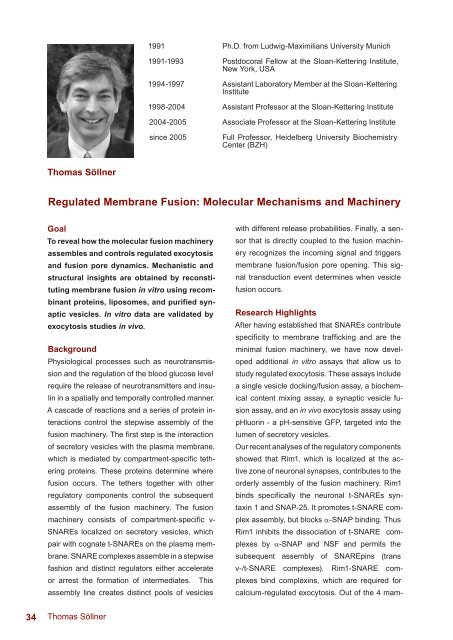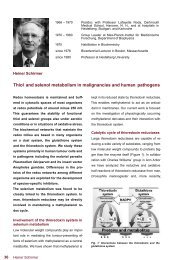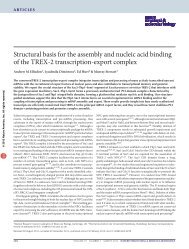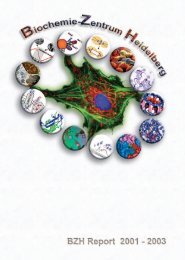Biochemie-Zentrum der Universität Heidelberg (BZH)
Biochemie-Zentrum der Universität Heidelberg (BZH)
Biochemie-Zentrum der Universität Heidelberg (BZH)
You also want an ePaper? Increase the reach of your titles
YUMPU automatically turns print PDFs into web optimized ePapers that Google loves.
34<br />
Thomas Söllner<br />
Goal<br />
To reveal how the molecular fusion machinery<br />
assembles and controls regulated exocytosis<br />
and fusion pore dynamics. Mechanistic and<br />
structural insights are obtained by reconstituting<br />
membrane fusion in vitro using recombinant<br />
proteins, liposomes, and purified synaptic<br />
vesicles. In vitro data are validated by<br />
exocytosis studies in vivo.<br />
Background<br />
Physiological processes such as neurotransmission<br />
and the regulation of the blood glucose level<br />
require the release of neurotransmitters and insulin<br />
in a spatially and temporally controlled manner.<br />
A cascade of reactions and a series of protein interactions<br />
control the stepwise assembly of the<br />
fusion machinery. The first step is the interaction<br />
of secretory vesicles with the plasma membrane,<br />
which is mediated by compartment-specific tethering<br />
proteins. These proteins determine where<br />
fusion occurs. The tethers together with other<br />
regulatory components control the subsequent<br />
assembly of the fusion machinery. The fusion<br />
machinery consists of compartment-specific v-<br />
SNAREs localized on secretory vesicles, which<br />
pair with cognate t-SNAREs on the plasma membrane.<br />
SNARE complexes assemble in a stepwise<br />
fashion and distinct regulators either accelerate<br />
or arrest the formation of intermediates. This<br />
assembly line creates distinct pools of vesicles<br />
1991 Ph.D. from Ludwig-Maximilians University Munich<br />
1991-1993 Postdocoral Fellow at the Sloan-Kettering Institute,<br />
New York, USA<br />
1994-1997 Assistant Laboratory Member at the Sloan-Kettering<br />
Institute<br />
1998-2004 Assistant Professor at the Sloan-Kettering Institute<br />
2004-2005 Associate Professor at the Sloan-Kettering Institute<br />
since 2005 Full Professor, <strong>Heidelberg</strong> University Biochemistry<br />
Center (<strong>BZH</strong>)<br />
Regulated Membrane Fusion: Molecular Mechanisms and Machinery<br />
Thomas Söllner<br />
with different release probabilities. Finally, a sensor<br />
that is directly coupled to the fusion machinery<br />
recognizes the incoming signal and triggers<br />
membrane fusion/fusion pore opening. This signal<br />
transduction event determines when vesicle<br />
fusion occurs.<br />
Research Highlights<br />
After having established that SNAREs contribute<br />
specificity to membrane trafficking and are the<br />
minimal fusion machinery, we have now developed<br />
additional in vitro assays that allow us to<br />
study regulated exocytosis. These assays include<br />
a single vesicle docking/fusion assay, a biochemical<br />
content mixing assay, a synaptic vesicle fusion<br />
assay, and an in vivo exocytosis assay using<br />
pHluorin - a pH-sensitive GFP, targeted into the<br />
lumen of secretory vesicles.<br />
Our recent analyses of the regulatory components<br />
showed that Rim1, which is localized at the active<br />
zone of neuronal synapses, contributes to the<br />
or<strong>der</strong>ly assembly of the fusion machinery. Rim1<br />
binds specifically the neuronal t-SNAREs syntaxin<br />
1 and SNAP-25. It promotes t-SNARE complex<br />
assembly, but blocks a-SNAP binding. Thus<br />
Rim1 inhibits the dissociation of t-SNARE complexes<br />
by a-SNAP and NSF and per mits the<br />
subsequent assembly of SNAREpins (trans<br />
v-/t-SNARE complexes). Rim1-SNARE com-<br />
plexes bind complexins, which are required for<br />
calcium-regulated exocytosis. Out of the 4 mam-







